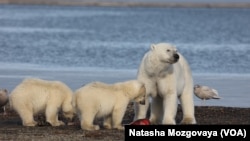In the Arctic, the impact of climate change is happening at an accelerated pace, with temperatures rising two to four times faster than the global average.
“It’s called the polar amplification,” explains Vladimir Romanovsky, a geophysicist at the University of Alaska in Fairbanks. “Snow and ice reflect lots of energy back to space when ice and snow are melting, and the surface turns much darker. So this amount of energy will be absorbed by the surface, and it will make the surface warmer – at the same time making the atmosphere warmer as well.”
Communities in circumpolar regions of Alaska are dealing with a triple challenge of climate change: coastal erosion, thawing of permafrost on which buildings and infrastructure stand, and, for some communities, the challenge of managing encounters with apex predators — polar bears pushed onshore.
“An optimal habitat for polar bears now is basically absent, it’s disappeared,” says Todd Atwood, a wildlife biologist with the United States Geological Survey. He has been studying polar bears for the past 12 years and says melting sea ice makes it harder for bears to hunt seals.
“That tends to be the trigger for bears to either stay with the sea ice as it retreats further over those deeper waters, or, for a growing proportion of the population to make the swim to shore.”
In addition to the high risk of succumbing to sea conditions on a long swim, bears trying to adapt to life on land face an additional risk as they search for new sources of food.
“They're coming ashore in areas where people are active, whether it's near communities where people are engaged in subsistence activities, or whether it's in the oil and gas industrial footprint where people are working [outdoors] on a daily basis,” Atwood says. “And that raises the likelihood of human-bear interactions and conflict.”
In the Inupiat village of Kaktovik on Alaska’s North Slope, posters warn people to be on the lookout for polar bears.
Six hundred kilometers from the nearest big city, Kaktovik hosted visitors on polar bear tours before the COVID pandemic. Those restrictions are now lifted, but it’s contractors, not tourists, occupying the main hotel as they work to complete repairs to the local school and maintain infrastructure before the harsh winter weather and darkness set in.
Lee Kyoutak picks up visitors from the landing strip where small planes carrying a few passengers and supplies land when the island’s frequently foggy weather allows it. He says not to worry about hearing shots or firecrackers. “There's a polar bear patrol patrolling the village,” he said. “If you go out, just make sure you look around when you go out because there's polar bears hanging around.”
Kaktovik is one of six communities in North Alaska where residents receive special training provided by the North Slope Borough and the U.S. Fish and Wildlife Service to join Polar Bear Patrols that use non-lethal deterrents to haze bears who sneak into areas where people live or work.
In traditional indigenous communities such as Nuiqsut, Utqiagvik (Barrow), and Kaktovik where there is seasonal whale hunting, polar bears attracted to bowhead whale bones discarded outside the village keep those patrols especially busy. Some encounters between bears and humans can be lethal — for either side.
Inupiat wildlife guide Robert Thompson says he rarely walks around the village unarmed, especially at night.
“I had to shoot two bears that came after me,” he said. “I don’t want to do it, but when bears come after you, you got to defend yourself. One was four to five feet from my doorway, and another one tried to jump into the house though my bedroom window.”
Thompson came to Kaktovik more than 50 years ago. Back then, he says “ice was visible all summer. Pack ice, meaning ice that doesn't melt. And so, recently, we had 700 miles of open water toward the North Pole. So that's affecting the polar bears. With the ice around us melting, they are trying to swim ashore. The cubs don't make it.”
Scientists have recorded polar bears swimming as far as 350 kilometers over several days. Even strong swimmers may not survive the challenge.
Research led by the U.S. Geological Survey shows that in the first decade of the 21st century, the number of polar bears in the southern Beaufort Sea dropped 40%.
“One of the things that we're pretty confident of as a polar bear research community is that without sea ice, you're not going to have polar bears,” Atwood said. “They represent a kind of the canary in the cryosphere in the sense that they are the animal that is probably most associated with the threat of climate change to wildlife persistence.”
The International Union for Conservation of Nature lists the polar bear as a vulnerable species most threatened by the loss of sea ice. With an estimated 26,000 bears remaining worldwide, the group says all but a few of those bears could be lost by the end of the century without action on climate change.











